You have no items in your shopping cart.
orange
-
Yellowing Leaves on Citrus Trees
Hi and welcome fellow Citrus growers!

One of the questions I often receive is "Why are the Leaves Yellow" on my Citrus Tree? More often, specifically on the Meyer Lemon Tree which is the most the most popular of all Indoor Citrus trees.
We will address what causes the leaves to turn yellow and the specific remedies to correct this common issue.Reason #1: NATURAL SHEDDING AND LEAF DROP:
It is common for the leaves at the bottom of the tree or in the interior that are not receiving much sunlight to naturally turn yellow and drop. If you only have a few yellow leaves in those locations then that is natural and part of the trees normal leaf shedding process and poses no concern.
Reason #2: EXTENSIVE YELLOW LEAVES THROUGHOUT THE TREE WITH LEAF DROP:
This is normally caused by an overwatering situation and/or poor drainage. When the roots sit in soggy soil they will begin to rot and they will lost their ability to carry nutrients up to the canopy of the tree. You may need to change your pot out with good drainage holes and if you re-pot make sure the potting soil you use is lightweight and does NOT contain wetting agents. Secondly, amend your watering and fertilizing as noted below to get your plant on a healthy path (It will take several months to correct this issue, be patient).
Reason #3: YELLOW AND MOTTLED GREEN LEAVES THROUGHOUT THE TREE:
This is an indication that your plant needs some food. I recommend you feed your plant at least every (3) months but to really give your a plant a "POP" feed monthly starting in March all the way through November. Proper plant food and watering coupled with sunshine will help your plant thrive and aid in its blossoming/fruit production.
WATERING:
Consistency is the key with citrus watering. Citrus trees require soil that is moist but never soggy. Watering frequency will vary with soil porosity, tree size, and environmental factors. DO NOT WATER IF THE TOP OF THE SOIL IS DRY WITHOUT CHECKING THE SOIL AT ROOT LEVEL! A simple moisture meter, available at garden supply stores, will read moisture at the root level. This inexpensive tool will allow you to never have to guess about whether or not a plant needs water. It is better for the soil to be on the dryer side when you water.
A wilted tree that perks up within 24 hours after watering indicates the roots got too dry. Adjust the watering schedule accordingly. A tree with yellow or cupped leaves, or leaves that don't look perky AFTER watering can indicate excessive watering and soggy roots. Give your tree water less often.
Citrus prefer infrequent, deep watering to frequent, shallow sprinklings. Deeper watering promotes deeper root growth and strengthens your tree. Generally, once or twice a week deep watering works well for container specimens. Be sure to adjust based on weather conditions! In general, it is probably best to water in the morning, but if plants are dry or wilted it is better to water them right away than wait until morning.
FERTILIZER:
Citrus trees feed heavily on nitrogen. Your fertilizer should have more nitrogen (N) than phosphorous (P) or potassium (K). Use at least a 2-1-1 ratio (For example; a 15-6 -8 or 12-4-5 or 18 - 8-10 would work well ... remember you do not have to be exact, just try to find one that the first number is about twice as high as the other numbers). Miracid Soil Acidifier is a water-soluble product that works well and is a 3-1-1 ratio. In some regions, you may be able to find specialized citrus/avocado fertilizers. Buy a good brand and apply according to package directions. Osmocote slow release plant food is another good fertilizer.
Any good citrus formula will contain trace minerals like iron, zinc, and manganese. Many all-purpose products will work. Just add trace mineral supplements if your fertilizer is deficient. We prefer slow release fertilizers in the granular form rather than fertilizer stakes. Follow the instructions on the package carefully as fertilizers come in different strengths, release rates, and application schedules. We recommend that you fertilize more often than recommended with most slow release fertilizers. Foliar applications of trace minerals in the form of kelp or other soluble fertilizers can be effective.
Check out our Video Tutorials that cover many of these same issues by clicking here.
Wishing you great success with your Citrus Growing!
George
-
DYI Orange Slice Ornaments for Christmas
 Christmas is just around the corner! This is one of our favorite times of the year. To celebrate we will be running sales until Christmas, so be sure to check our Facebook for our newest coupon. Click here for a printer friendly version of this project.
Christmas is just around the corner! This is one of our favorite times of the year. To celebrate we will be running sales until Christmas, so be sure to check our Facebook for our newest coupon. Click here for a printer friendly version of this project.The holiday season is all about family and there is no better way to celebrate family than spending quality time with your kids. So here is a fun project that you can do with the little ones while making your house smell wonderful with the freshness of oranges.
The ornaments also serve a practical purpose if you have cats. Cats hate the smell of citrus, so when you use these ornaments they will avoid your Christmas tree!
Pretty Orange Slice Christmas Ornaments
Now this recipe is not limited to just oranges, you can try this with any citrus that you have but oranges tend to have a longer lasting smell and the smell mixes well with the cinnamon used in the recipe, so good that you might be tempted to eat the ornaments!
Here are some popular varieties used to make ornaments.
Large Orange Varieties: Washington Navel; Valencia; Summerfield
Medium Orange Varieties: Owari Satsuma; Red Navel "Cara Cara"; Moro Blood
Small Orange Varieties: Clementine; Calamondin; Louisiana Sweet
(Note: Blood Oranges keep true to the traditional red Christmas color, so if you're not too sure about putting the color orange on your tree; then you can opt for the Blood Orange instead.)
Things you need:
Oranges (4 Large Oranges, 6 Medium Oranges or 8 Small Oranges to provide good coverage on a 7' Christmas Tree)
Sharp Knife (appropriate for slicing the oranges)
Hobby or Exacto Knife
Fabric Ribbon
Scissors
Paper Towel
Ground Cinnamon or Cinnamon Oil (optional)
Cotton Swabs (optional for use with Cinnamon)
Glitter (optional)
Glue (optional for use with Glitter)
Directions:
1. Preheat your oven to 275 degrees Fahrenheit.
2. Slice the oranges crosswise into 1/4 inch thick slices, discard the ends. If your oranges have seeds, remove them and discard. Lay the slices on paper towel. Use paper towels to blot excess juice on the slices.
3. Apply Cinnamon to a Cotton Swab and apply the Cotton Swab to the white rind of the orange very generously. Be sure to not get cinnamon on the actual fruit because it will darken the area which will not allow the Christmas lights on your tree to shine through the fruit. (optional)
4. Place the orange slices directly on the oven rack for best results. You may use a cookie sheet but if you do you need to spray the orange slices very lightly with cooking spray or they will stick. Allow slices to bake in the oven for an hour.
5. Turn down the temperature in the oven to 215. If you used a cookie sheet, you may need to flip the orange slices for even drying. Once turned, return to oven to dry for an additional two hours. Once two hours has passed check the slices for dryness. If the slices are not dry allow for more time, be sure to check the slices often. Once they are dry, allow to cool completely.
6. Take the Hobby Knife and cut a 1/3 inch slit into each orange just under the rind.
7. Cut a piece of Ribbon at least six inches long with your scissors and fish the ribbon through the slit you just made on the orange slice. Then tie a bow towards the two ends of the ribbon, so you have a hoop that you can use to secure the ornament on the tree.
6. Now you can get the kids involved by decorating the orange slices. You can glue the Glitter as suggested in this recipe or decorate any other way you like! It's best to use a very thin coat of white Elmer's glue. Be very careful to use the glue very sparingly, you don't want to rehydrate the orange slice! Silver or Gold Glitter lightly applied to the fruit of the orange gives a lovely sparkling glow when close to lights on the Christmas Tree. Be sure to allow any glue to dry completely.
7. Decorate Your Christmas Tree!
Happy Holidays & Merry Christmas from LemonCitrusTree!
2 Item(s)





